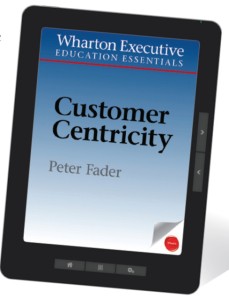Archive
Interview with Peter Fader on Customer Centricity
A few months ago, I posted a review of Peter Fader’s book, Customer Centricity. Recently, my colleague Ramesh sat down with Peter to discuss inspiration for the book as well as key ideas within it.
Here are some of the highlights of the interview. If you a fan of Peter’s like me, I think you will enjoy it.
Are You “Customer Centric”?
More great stuff from the folks at the Wharton Customer Analytics Initiative (WCAI).
Yesterday, Wharton Professor Peter Fader released a new book entitled Customer Centricity. I had the privilege of reviewing a pre-release copy of the book and was struck by some really interesting and insightful points that Peter highlights in it.
Specifically,
Did you realize that some of the greatest brands in business history- Starbucks, Nordstrom and yes, even Apple have a long way to go in terms of optimizing the value of their customers?
Shocking right? But Peter makes a compelling case that some of the most successful (and valuable) companies still have room to grow in terms of deepening their understanding of their existing customers and using this information to create custom offerings that strengthen ties and add to the value of the customer relationships that these companies already have.
Did you know that oversimplification of how you classify customers has significant consequences in terms of the effort/investment that you should be making to make your most important customers happy?
There is a great discussion (and a specific example on the wireless industry) in the book about how an oversimplified view of customer churn can cause companies to overlook and under-invest in some of their most important relationships.
Did you know that analysis of customer value could represent an entirely new way of evaluating investment choices?
In the book, Peter introduces the idea of customer equity (the combined lifetime value of all of its customers) as an increasingly accepted metric for considering the value of certain types of firms. While challenging to execute, Peter points out that this may be an approach that is far more tangible and quantifiable than other measures such as brand equity.
These are but a few of the topics that he compellingly covers in this book. Peter is quick to point out that his ideas on customer centricity are more applicable to certain types of companies, but if you are a part of an entity that has large numbers of customers, sells services on a subscription basis (SaaS providers- are you listening?), has the ability to create custom offers, or is interested in investing in companies that have these characteristics, then this book lots to offer. I would highly recommend it.
For more information on the book and how to get it, click here.
